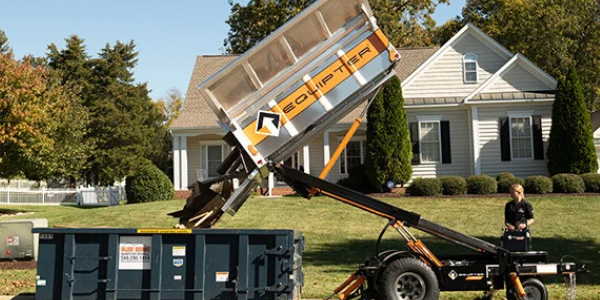Building back stronger after storms

By Equipter.
Whether you are performing short- or long-term repairs and restorations, the Equipter 4000 can make your life a little bit easier.
In the aftermath of extreme storm events, such as hurricanes and tornadoes, everything from homes to business to industrial spaces and beyond, can suffer substantial damages. Contractors and roofers are often faced with an incredibly large number of repair and restoration requests, as the community around them tries to find a semblance of normal again. Because of the demand of this work, these professionals often work around the clock for weeks and even months to build back stronger. Here at Equipter we recognize how important this work is, and how exhausting it can be. That’s why contractors need innovative technology and equipment, like the Equipter 4000, to help them in their recovery efforts.
Immediate response
In the hours and days following a major storm event, foresight and storm preparedness can make a big difference. Promptly clearing debris on major roadways allows for emergency services to pass through. Excavators and backhoe loaders can be used to dig and lift debris impeding the flow of traffic. Skid steer loaders and bulldozers can be used to clear large piles of debris or damaged structures. The Equipter 4000 is a unique tool that allows loaders, excavators and even ground crews to move debris away from a site by placing trash into the Equipter and driving or towing it away.
In the immediate aftermath of a storm, it is worth considering what type of equipment is best suited for the situation: gas-powered equipment or battery-powered equipment. For immediate response scenarios, gas-powered equipment like excavators and loaders can get to work right away in places where electricity may not be available for days. The gas-powered, self-propelled Equipter 4000 is a perfect tool for remote areas where its versatility in material handling is a distinct advantage when individual tools may not be available.
Short-term restoration
Right after a storm event, some residences may need immediate temporary repairs until problems can be addressed at a later time. This might include impromptu roof patching or stabilizing structures. In the days and weeks following a storm event, contractors can come back and assess long-term roofing and structural repairs.
At the same time, crews will work to repair downed power lines while other crews aim to get water and sewer services back online. Generators may be brought in to supply electricity until aerial work platforms and cranes can come in to fully restore power. Water pumps and trenchers are necessary to drain flooded areas and repair drainage systems.
After critical services are restored, crews will work to repair infrastructure and clear debris from public and private property. Telehandlers and cranes can be used to lift and place materials while dump trucks can move debris off site. The Equipter 4000 can be used to gather debris and then, once the Equipter is hitched to a vehicle, it can tow debris away from a site. Once the Equipter operator reaches their destination, the Equipter 4000 can lift its box and deposit refuse.
Long-term restoration
Contractors who work in areas where storm damage is common will already know that some community restoration projects can take months or even years to fully address. Residences with minor damage may wait until more pressing jobs in their community — repairing schools and hospitals for example — have been completed. In the months following a storm, contractors will work diligently to repair homes that were damaged and are still in need of help. With so much work to tackle, working efficiently on each job is a crucial component to bringing communities back to normal as quickly as possible.
The Equipter 4000 is available to rent from over 400+ rental providers across the United States and Canada. If you need help to manage debris after a storm event, please visit our rental map and reach out to the rental provider closest to you.
Original article and photo source: Equipter
Learn more about Equipter in their Coffee Shop Directory or visit www.equipter.com.






















Comments
Leave a Reply
Have an account? Login to leave a comment!
Sign In